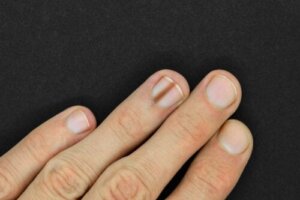Nail Melanonychia: Causes and Treatments

‘Nail melanonychia’ is a term used to refer to dark pigmentation of the nails, both fingernails, and toenails. In certain people, it’s a physiological feature, but it can also be the symptom of an underlying health problem.
In particular, it has been linked to melanoma, bacterial or fungal infections, or other skin diseases. That’s why it’s so important to investigate its cause in order to avoid serious complications. How to identify it? In the following article, we’ll tell you more about its symptoms, diagnosis, and possible treatments.
What is nail melanonychia?
Nail melanonychia is a condition of the nails. The nails are convex, semi-transparent structures located on the distal part of the fingers. They’re mainly made up of dead cells containing keratin, a fibrous protein that gives them firmness and resistance.
Physiologically, there’s no melanin in the nails. This is the substance responsible for skin pigmentation. What happens in nail melanonychia is that melanin causes discoloration of the nails because it’s present in the nails.
It may appear as a single dark band or stripe on the nail surface. In other cases, it spreads throughout the entire structure, causing discoloration throughout the entire piece. Its appearance is usually brown or black. In addition, it may appear on one or more nails.
The symptoms of nail melanonychia
The main clinical manifestation of nail melanonychia is the appearance of a brown, black, or grayish longitudinal band. This usually starts at the matrix, but extends towards the end of the nail plate. In rare cases, it involves the entire nail or originates as a transverse band.
According to information from Dermatology Research and Practice, the dark coloration is due to an increase in the number and function of melanocytes. The latter are the cells responsible for synthesizing melanin.
When the color is gray, the cause is hyperpigmentation of the epithelium.
It’s possible that the nail also presents several colors and that the lines that make up the nail melanonychia are wide. In addition, if the cause is a malignant tumor, other serious symptoms may be present, such as the following:
- Nodules
- Ulcerations
- Nail dystrophy
- Involvement of the surrounding skin
- Pain (in rare cases)
Types of nail melanonychia
Depending on the discoloration of the nail, different types of nail melanonychia can be distinguished. Let’s take a look:
- First, we find longitudinal or striated melanonychia. This is the most common form. In this case, there is only a long, longitudinal band along the nail.
- The second type is diffuse or total melanonychia. What happens is that the discoloration affects the entire nail plate.
- Finally, it can be transverse. The color line crosses the nail transversely.
What are its causes?
Nail melanonychia occurs due to an increase in the number of melanocytes or their activity. That is, it occurs when there’s a higher than normal melanin production.
- An increase in the number of melanocytes in the nail is called ‘melanocytic hyperplasia’. This condition can be benign, but in some cases, it also has characteristics of malignancy.
- When it occurs due to increased melanin production, it’s called ‘melanocytic activation’.
However, there are many pathologies or situations that can lead to nail melanonychia. We’ll explain them in the following sections.
Infections
Certain infections, both fungal and bacterial, can lead to nail melanonychia. Some fungi are capable of producing melanin, which is incorporated into the nails. It’s more common on the feet, as they’re subjected to more continuous moisture.
Some bacterial infections, typical of people with a weakened immune system, lead to this. For example, Pseudomonas infection. It can even be observed in people with human immunodeficiency virus.
Injuries and skin conditions
Blows to the hands or nails can cause nail melanonychia. The same is true for numerous skin diseases. This pathology has been described in the context of psoriasis, lichen planus, or amyloidosis.
We think you may also like to read this article: Press-on Nails: What Are They, and What Are Their Advantages and Disadvantages?
Systemic diseases and pregnancy
Certain diseases, such as Addison’s disease or Cushing’s syndrome, can lead to this condition. The same is true for some vitamin deficiencies, such as vitamin B12 deficiency. Malnutrition has also been linked.
Although it isn’t a disease, pregnancy has been found to be a time when the incidence of nail melanonychia increases. In fact, in this case, it’s common for several different toes to be affected.
Medications
Some drugs, especially those used for chemotherapy, can cause melanonychia. This is one of the most common causes of transverse nail banding.
Tumors
Both benign and malignant tumors can cause nail melanonychia. For example, squamous cell carcinoma is one type of cancer that can cause it. The same is true for acral lentiginous melanoma. This is a rare, infrequent type of melanoma that affects the nails.
Lentigo is another associated benign condition, as is nail matrix nevus. The latter is the most common cause of melanonychia in children. It’s characterized by the presence of ‘nests’ of melanocytes. That is, by accumulations of melanocytes at the affected site.
Risk factors
Nail melanonychia can occur in people of all ages and races. However, it affects African-Americans and Japanese more frequently. So much so that its incidence is estimated to be greater than 75% in African Americans and as high as 20% in Asians.
However, this condition is rare in Caucasians. The skin types most affected, according to Fitzpatrick’s classification, are V and VI.
Furthermore, age can also be considered a risk factor; it’s particularly seen in people over 50 years of age.
Other associated factors have to do with the work environment. People who work in continuous contact with water or wet substances are more likely to develop nail melanonychia due to infections.
The same applies to frequent exposure to trauma. Whether at work, during certain sports activities, or any other action, shocks can lead to melanonychia.
The diagnosis and treatment of nail melanonychia
Diagnosis of nail melanonychia can be complex. In some cases, it’s sufficient to analyze the clinical picture and have an obvious trigger, such as a blow. However, in many other patients, it’s necessary to resort to complementary tests to achieve a definitive diagnosis.
The most commonly used test is a biopsy. It consists of extracting a sample of the affected nail and analyzing it in the laboratory. The objective is to rule out if it is a malignant pathology such as melanoma. It’s essential to perform it in cases of sudden onset or a history of melanoma.
The treatment of nail melanonychia will depend on its cause. If it’s a benign process, it is likely that no intervention will be necessary. However, if it’s malignant, surgery may be suggested. The surgical procedure may be based on removing the nail or even the finger.
Like this article? You may also like to read: How to Strengthen Your Fingernails Naturally: 5 Tips
What you should remember
Nail melanonychia is a pathology that consists of abnormal and dark pigmentation of one or more nails. This condition can be due to multiple causes, both benign and malignant. For example, it can be a symptom of melanoma.
It’s therefore essential to always consult a physician in the event of this sign. Early diagnosis can significantly improve the prognosis by allowing early treatment.
All cited sources were thoroughly reviewed by our team to ensure their quality, reliability, currency, and validity. The bibliography of this article was considered reliable and of academic or scientific accuracy.
- Darmawan, C. C., Ohn, J., Mun, J., Kim, S. H., Lim, Y., Jo, S. K., Kim, Y., Kim, B., Seong, M. W., Kim, B., Lee, C., Kwak, Y. L., Chung, H. S., Viros, A., & Lee, D. M. (2022). Diagnosis and treatment of nail melanoma: a review of the clinicopathologic, dermoscopic, and genetic characteristics. Journal of The European Academy of Dermatology and Venereology, 36(5), 651-660. https://doi.org/10.1111/jdv.17975
-
Gradinaru, T. C., Mihai, M., Beiu, C., Tebeica, T., & Giurcaneanu, C. (2020). Melanonychia – Clues for a Correct Diagnosis. Cureus, 12(1), e6621. https://www.ncbi.nlm.nih.gov/pmc/articles/PMC7008765/
- Institute for Quality and Efficiency in Health Care (IQWiG). (2018, 28 junio). Structure of the nails. InformedHealth.org – NCBI Bookshelf. https://www.ncbi.nlm.nih.gov/books/NBK513133/
-
Jefferson, J., & Rich, P. (2012). Melanonychia. Dermatology research and practice, 2012, 952186. https://www.ncbi.nlm.nih.gov/pmc/articles/PMC3390039/
-
Khan, K., & Mavanur, A. A. (2015). Longitudinal melanonychia. BMJ case reports, 2015, bcr2015213459. https://www.ncbi.nlm.nih.gov/pmc/articles/PMC4680278/
-
Ohn, J., Bae, J. M., Lim, J. S., Park, J. S., Yoon, H. S., Cho, S., & Park, H. S. (2017). Acral Lentiginous Melanoma, Indolent Subtype Diagnosed by En Bloc Excision: A Case Report. Annals of dermatology, 29(3), 327–330. https://www.ncbi.nlm.nih.gov/pmc/articles/PMC5438940/
-
Plachouri, K. M., Kolonitsiou, F., & Georgiou, S. (2019). Melanonychia Striata: Nail Alterations during Pregnancy. Skinmed, 17(6), 413–414. https://pubmed.ncbi.nlm.nih.gov/31904335/
-
Singal, A., & Bisherwal, K. (2020). Melanonychia: Etiology, Diagnosis, and Treatment. Indian dermatology online journal, 11(1), 1–11. https://www.ncbi.nlm.nih.gov/pmc/articles/PMC7001389/
-
Trivedi, M., Mehta, R. D., Kumar, H. S., Ghiya, B. C., Soni, P., Meena, M. K., Kumar, V., & Rekha, S. (2020). Nail Changes Caused by Chemotherapy among Cancer Patients: A Cross-Sectional Study of Northwest Rajasthan. Indian dermatology online journal, 11(6), 953–958. https://www.ncbi.nlm.nih.gov/pmc/articles/PMC7734979/
-
Visuvanathan, V. V., & Koh, K. C. (2015). Dark fingernails. Malaysian family physician : the official journal of the Academy of Family Physicians of Malaysia, 10(3), 40–42. https://www.ncbi.nlm.nih.gov/pmc/articles/PMC4992355/
- Ward, W. H. (s. f.). TABLE 1, Fitzpatrick Classification of Skin Types I through VI – Cutaneous Melanoma – NCBI Bookshelf. https://www.ncbi.nlm.nih.gov/books/NBK481857/table/chapter6.t1/
This text is provided for informational purposes only and does not replace consultation with a professional. If in doubt, consult your specialist.









